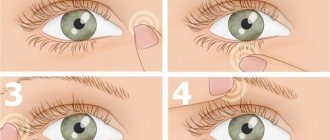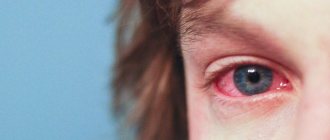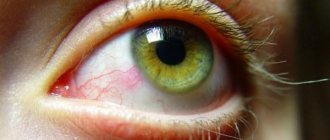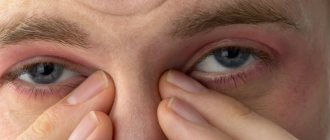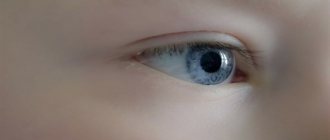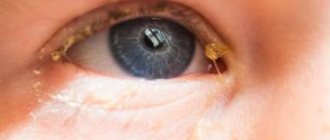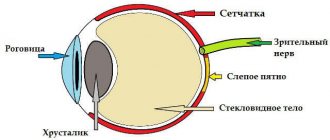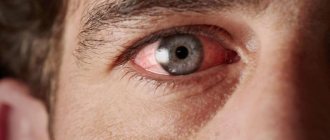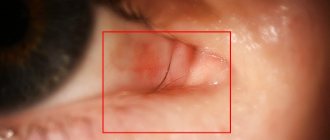Causes of nervous tics
Ophthalmologists call this deviation blepharospasm. The violation is quite common; every second person has encountered it at least once in their life. Moreover, for some, the tic persists for several years. Blepharospasm develops due to the fact that the nerve endings concentrated in the area of the organ of vision are very “delicate” and quickly react to any irritants in the form of a tic.
The eye twitches for the following reasons:
- Fatigue associated with prolonged work at the computer or watching television.
- Depression, neurosis, stress.
- A lack of useful elements in the body provokes a short-term eye tic.
- Some medications prescribed for the treatment of ophthalmic diseases have side effects in the form of twitching of the organ of vision.
- Typically, a tic signals problems with the nervous system, regardless of what caused the development of the deviation.
| Also, blepharospasm can provoke severe fear; less often, the disease is hereditary. Modern doctors have developed a theory according to which such symptoms indicate a violation of the functionality of the liver. Since the nerve endings of this organ are connected to the area in the area of the visual apparatus. |
ICD-10 code
Nervous tics are a large group of diseases that are united under one code, despite the fact that each of them has its own characteristics. This is due to the fact that any of them is characterized by rapidly repeating non-rhythmic movements that are of an involuntary nature. A separate group includes hyperkinesis, myokymia, blepharospasm and a number of other diseases and symptoms in which a nervous tic affects the visual organs.
Tiki (F95).
Hyperkinesis (R25.8.0).
Facial myokymia (G51.4).
Blepharospasm (G24.5).
Symptoms
A nervous eye tic is especially noticeable to people around you. Muscle twitching begins unexpectedly; at the initial stage, willpower will help to cope with it. But eventually, after a certain period of time, the tick will repeat again.
In some people, such a deviation manifests itself at a moment of psychological or physical stress. Others experience tics while resting. Focused attention can provoke an attack, this is especially true for children.
In children
Eye twitching is most often encountered in preschool age. Doctors explain this by the fact that during this period the formation of the child’s psyche is actively underway and even minor emotional trauma can negatively affect the functioning of the nervous system.
A distinctive feature of the course of blepharospasm in children is that he himself does not consider such a phenomenon to be a deviation. If parents do not pay attention to the twitching and do not attack the child with questions, then he will not feel his vulnerability.
During pregnancy
In the process of bearing a child, expectant mothers often encounter such a phenomenon as a nervous tic. Since girls are worried about their situation, they are characterized by some nervousness. To eliminate twitching, it is important to calm down and devote more time to rest and walks in the fresh air.
The tic may last for a few seconds or last for a couple of days. Its duration is directly related to the state of the nervous system. Taking prescribed medications and following the recommendations of your doctor will significantly reduce the time of twitching.
The deviation in no way affects the functioning of other systems and does not reduce the performance and intellectual capabilities of a person. But it can have a negative impact on self-esteem, since one feels a negative attitude from others.
Prevention measures
The following tips will help prevent the appearance of nervous tics:
- Set aside at least 8 hours a day for sleep.
- Make it a habit to play sports, such as swimming.
- Organize daily walks in the fresh air. Their duration must be at least two hours.
- Find a way to calm yourself during times of stress. This could be meditation or relaxing music.
- When faced with a stressful situation, try to calm down. To do this, you can take deep breaths and exhales.
Timely diagnosis of diseases of the body as a whole and the visual organs will also help to avoid the occurrence of the symptom of eyelid twitching.
Features in children
According to statistics, every tenth child experiences such a phenomenon as a nervous tic. The risk group includes children from two to eighteen years of age. Children aged seven to eleven years require special attention. Because it is during this period that their psyche is highly susceptible to stress.
And if you do not take care to exclude factors that can provoke the development of a tic, the location of the symptom may change. And the process itself will become pathological. In other words, the child will develop persistent and uncontrollable jerking of the limbs.
Possible complications of tics
Eye twitching in itself is not dangerous to health, but only if the symptom occurs rarely. But with the regular occurrence of unpleasant symptoms, the risk increases in the form of constant contraction of muscle groups.
| However, the main danger of tic is that it can spread to other parts of the body. At the same time, sometimes doctors diagnose the development of a serious disorder called Tourette syndrome. |
Return to contents
Blepharospasm
A more dangerous condition if the eye twitches is called blepharospasm. This is an involuntary and uncontrollable contraction of the orbicularis muscle surrounding the eye. The muscle twitches under and above the eye, which leads to a spasmodic closure of the eyelids. Blepharospasm is accompanied by swelling of the eyelids, lacrimation, hypersensitivity to light, and dry eyes. At first, attacks of blepharospasm end quite quickly, but as the underlying disease worsens, they become longer lasting and can eventually last all day.
Blepharospasm occurs with neuropathy and neuritis of the facial and trigeminal nerve, facial hyperkinesia
Branches of the trigeminal nerve run along each side of the face, so when it is inflamed, for example, when the right eye twitches, the corresponding cheek may become numb, tremble, and become very sore.
Determining the cause of blepharospasm is important in determining how to treat the condition. It can be caused by:
- blepharitis (inflammation of the eyelids);
- scratches and microtraumas of the cornea;
- dry outer membrane (decreased tear production);
- entropion (internal inversion of the eyelid);
- glaucoma (in the stage of damage to the optic nerve);
- photosensitivity;
- trichiasis;
- uveitis
Diagnostics
The diagnosis is made based on a visual examination of the patient. Since a tic can signal the development of abnormalities in other organs, a detailed examination is required.
The main diagnostic methods include:
- encephalography of the brain;
- ultrasound of internal organs (especially the liver);
- blood sampling for analysis with determination of microelements;
- Children are tested for helminths in their stool.
Based on the data received, the doctor selects a course of treatment. Most often, eliminating the root cause of twitching leads to a decrease or disappearance of the defect.
Treatment of nervous eye tics
Patients faced with such a deviation often ask the question: “How to remove a nervous tic from the eye?” The course of therapy includes the use of medications, performing special gymnastics and the use of traditional medicine recipes. Only comprehensive treatment will allow you to get rid of unpleasant symptoms or minimize their manifestation.
Drug therapy
The main group of drugs prescribed to combat eye twitching are sedatives (calming drugs). Treatment begins with light medications. It is best to stick to products with a plant base (valerian, motherwort).
It is recommended to take a course of magnesium and calcium, microelements are responsible for the transmission of nerve impulses. When treating tics, it is better to choose natural medications instead of pills.
| Treatment of children is primarily aimed at stabilizing relationships within the family. A calm and friendly atmosphere will help minimize the occurrence of twitching. You need to learn not to focus on deviation, then the baby will treat it adequately. |
In severe cases, adults are prescribed Botox injections. The drug gives muscles elasticity, resulting in reduced visibility of muscle contractions.
Treatment with traditional methods
Herbs that have a sedative effect will help you relax and relieve tension. This allows you to get a good night's rest, which is an important factor when dealing with tic.
If twitching is caused by visual fatigue, use tea, bay leaf or a decoction of their anti-inflammatory herbs. A cold compress applied to the area affected by the tic will help reduce the visibility of muscle contractions. As the water warms up, the lotions need to be changed.
A honey compress will help relieve tension. It is made from melted sweetness. Cotton pads are soaked in syrup, applied to the eye area and left for several minutes.
For ticks, it is recommended to take a relaxing bath with essential oils and sea salt. Warm water will relieve tension. A cup of soothing tea will help enhance the effect.
Treatment methods
Before the disease becomes chronic, it is necessary to undergo examination by the following specialists:
- neurologist;
- ophthalmologist;
- psychotherapist.
If the patient has suffered a skull injury, concussion, meningitis, or the child was born after a difficult birth (also in the case of a genetic predisposition), then you should consult a neurologist. An ophthalmologist is needed to rule out or confirm the presence of eye disease.
A psychotherapist will help those who developed it as a result of stress or a serious quarrel to get rid of the disease. A specialist will help bring to light the hidden causes of eyelid twitching that were stored on a subconscious level. Sometimes, to eliminate hyperkinesis, it is enough to resolve a serious conflict in the workplace or at home.
The eye and lower eyelid twitch (causes and treatment can be carried out using both medication and traditional methods), it is important to follow the recommendations of specialists, follow a sleep and eating schedule, strengthen stress resistance, and do not abuse coffee-containing drinks and alcoholic beverages.
Exercises
During periods of overwork, myokymia can occur several times a day, and additional symptoms such as red eyes, weakness, and blurred vision may appear. First of all, it is important to master relaxing practices, establish a daily routine and restore blood circulation in the eye area.
The following exercises can be used at home.
"Butterfly"
The exercise is aimed at eliminating the main symptom - involuntary contraction of the eyelids. You need to start with the work of imagination: you need to imagine that instead of eyelids, the eyes are framed by the wings of a butterfly.
So, the workout:
- Blink very quickly (as fast as possible) 5 times.
- Close your eyes tightly, then open your eyes sharply. This must be done until tears appear.
- Close your eyelids and massage them with light movements of your index fingers, drawing circles.
- Blink frequently for half a minute.
- Half close your eyes. Try to calm the trembling of the eye muscles.
- Repeat step 3.
- Rest for a while in a calm state with your eyes closed.
If after performing the complex while resting the eyes continue to twitch, then all steps must be repeated.
"Day Night"
The patient’s task is to close his eyes several times a day for a few seconds, making a slight effort (as if squinting from the sun), then open his eyes and look into the distance. This procedure is especially necessary when working at a computer, reading for a long time or using gadgets.
It is important to keep an “observation diary”, trying to find the cause of such a violation. Thus, it will be possible to minimize the risks of this condition.
Palming for the eyes
This is a kind of massage of the eye muscles, as a result of which the level of tension decreases, visual acuity increases, and headaches disappear. To perform a treatment session, it is important to take a comfortable position, close your eyes with the palms of your hands, and then lower your elbows onto the table so that your neck and spine are in the same straight line. Next, you need to remember a pleasant episode in life that brought pleasant impressions.
You can do the exercise to music. The duration of the event is several minutes. Finally, open your palms slightly so that your eyes get used to the light. This procedure is easy to carry out in transport or during a break at the workplace.
To get rid of nervous tics, you can turn to alternative medicine.
Recipes from traditional medicine
The eye and lower eyelid twitch (the causes and treatment do not require drug intervention), then tension in the area of the eye muscles can be relieved with the help of:
- herbal compresses (lotions);
- use of sedative decoctions;
- infusions;
- herbal teas;
- aromatherapy.
Lotions
The best way to stop nervous eyelid twitching in a short time is a compress.
All you need to do is follow these steps:
- Soak a clean cloth (such as a scarf or towel) in cold water and apply to closed eyelids for 1/3 hour.
- As a result, vasoconstriction will occur, which will lead to muscle relaxation and, consequently, the disappearance of the problem.
A good compress is obtained with the addition of honey.
Prepare the solution as follows:
- 1 tsp Stir honey in a glass of ice water.
- Wet the cloth and apply it to your eyes.
- Keep the compress until the eyelid warms up.
- Then wet again. Do this several times.
Lotions can be made from:
- iced tea;
- infusion of bay leaf;
- chamomile;
- calendula;
- thyme;
- coltsfoot.
Traditional healers recommend using pure honey. To do this, you need to prepare tampons for application to the eyelids (for example, made of cotton wool or a bandage). Soak them in honey at room temperature and apply to the eyes for 10 minutes.
Geranium paste
To prepare a nourishing compress, you need to grind fresh geranium leaves to a mushy state. Apply to the eyelids (on closed eyes), place a piece of linen fabric on top and tie it all with a warm scarf or handkerchief. Session duration – 60 minutes. During this time, you need to completely relax and distract yourself from pressing matters as much as possible. The procedure should be performed daily for 5 days.
Soothing decoctions
To obtain a relaxing effect, it is recommended to use soothing decoctions throughout the day. Their action is targeted - relaxing the overexcited nervous system, normalizing blood circulation in the area of the heart muscle.
Remedies such as herbal teas made from lemon balm, chamomile, mint and other remedies stabilize the mental background and relieve external symptoms.
You can use the following recipe:
- Mix 3 tbsp. chopped chamomile, 2 - mint with lemon balm and 1 - valerian.
- Brew the raw materials with boiling water.
- Leave for 20 minutes.
- Drink warm 2 times: after waking up and before going to bed.
To strengthen the immune system, you can use mixtures with:
- St. John's wort;
- thyme;
- oregano;
- peppermint;
- rosehip.
It is recommended to take such drinks in courses of 2-3 weeks, but no more, in order to avoid excessive cumulative effects of the constituent components.
Essential oils
Essential oils that have the ability to relax and calm the central nervous system have an express effect in the process of getting rid of nervous twitching of the lower eyelid.
These include esters from:
- lavender;
- geraniums;
- cinnamon;
- mint.
It is enough to apply a few drops of the composition on a handkerchief, and when twitching of the eyelid occurs, inhale the healing aroma. You can also stuff a pillow with dried herbs and place it at your head.
For this purpose it is recommended to use:
- chamomile;
- rose hip;
- lavender;
- nettle;
- lemon balm;
- brewing green tea.
Medications
Medicines are prescribed by a specialist based on the cause of the disease. These are mainly drugs that relieve spasms and act on the brain.
In the list of drugs:
- Phenazepam;
- Clonazepam;
- Baclofen;
- Sulpiride;
- Glitsed;
- Novopasit.
Medicines that are prescribed for an illness such as Parkinson's disease, for example, cyclodol, may be prescribed.
Or multivitamin complexes containing:
- Vitamins:
- A;
- E;
- B.
- Minerals:
- magnesium;
- calcium;
- fluorine;
- iron.
Medications for the treatment of hyperkinesis should only be prescribed by the attending physician. Prescribing and taking medications on your own is strictly prohibited!
Nutrition
With periodic twitching of the lower eyelid, it is important to adjust your diet.
Food should be rich in:
- magnesium;
- potassium;
- iron;
- fluorine;
- calcium;
- fiber.
There is a certain list of products that help reduce the level of stress in the body, restoring the vital functions of the patient’s systems and organs in case of nervous breakdown and fatigue.
The diet should contain:
- bananas;
- oatmeal,
- yogurt;
- salmon;
- seaweed;
- beans;
- bread made from rye flour;
- pistachios;
- cashew nuts;
- seeds;
- red and black currants;
- blueberry;
- avocado;
- dark chocolate (but not confectionery with chocolate filling).
It is important to remove soda, coffee and alcoholic drinks, fried, spicy, canned and salty foods from your daily diet. It is recommended to spend fasting days, for example, on kefir or a vegetable smoothie, which will allow you to cleanse the intestines of toxins, as well as learn to control the body during periods of excitement or overexcitement (refusing to eat stress).
Relaxing treatments
The lower eyelid of the left or right eye may twitch due to overstrain of the body, and the cause of the disorder can be eliminated using relaxing procedures.
The following techniques will help during the treatment process:
- head and whole body massage;
- yoga (breathing exercises);
- meditation (relaxation and immersion in the true nature of one’s existence);
- The favorite music;
- aromatherapy;
- playing with children;
- swimming in the pool;
- doing what you love.
You can complement all this with relaxing walks through picturesque places, enjoying nature, taking in every breath of fresh air.
For complete relaxation, you can use spa treatments - the effects of light, water, heat, steam, sounds on the body. You can try honey, chocolate, seaweed wraps, massage of the cervical-collar and lumbosacral areas.
Exercise for the eyes
The first way to combat nervous tics is to perform special gymnastics:
- Close your eyes as tightly as possible and open them sharply. Repeat until tear fluid begins to be released.
- Massage the lower part of the organ of vision. After this, blink intensely for thirty seconds.
- Close your eyes halfway and hold them in this position until the slight trembling disappears. Then blink for a minute.
Charging gives a short-term effect, after some time the tick returns. Therefore, it is not suitable as primary therapy. Return to contents
Symptoms as a danger signal
Most often, nervous tics are not dangerous and are not accompanied by discomfort. However, for some people they become a reason to begin to develop complexes, which significantly aggravates their condition.
In many cases, nervous tics can be dealt with on your own. But there are a number of symptoms that indicate the need to see a doctor:
- Eye twitching every day for more than 10 days.
- Excessive spasm, leading to complete closure of the eyelid.
- Twitching of the eye, accompanied by contraction of other facial muscles.
- Redness and swelling of the eye.
Eyelid spasms may indicate diseases of the visual organs, atherosclerosis, brain cancer, and stroke. Therefore, when these signs are first detected, you should consult a therapist. Depending on the results of the examination and communication with the patient, he may refer him to an ophthalmologist or neurologist.
Disease prevention
Having appeared once, a nervous tic can return at any time. And sometimes at the most inopportune moment. To avoid such a situation, you need to learn to control emotions, exercise hardening and eat right.
Relaxation will help prevent twitching. Relaxing the body and using essential oils is very calming.
Nutrition
A person with an unstable nervous system and a tendency to develop tics needs to learn how to choose the right foods that will “supply” the body with useful substances and elements.
The diet must include:
- nuts;
- berries (cherry, black currant, blueberry, watermelon);
- Fish and seafood.
Such products are rich in magnesium and calcium and help strengthen the nervous system. It is necessary to minimize the consumption of alcoholic and carbonated drinks, coffee.
Relaxation
Anyone can learn to relax and turn off emotions from current events if they wish. There are various techniques aimed at relaxation in yoga. A daily relaxing massage will help you get a positive charge.
Relaxation is promoted by calm music and pleasant aromas of essential oils. Walking in nature also has a beneficial effect on the nervous system. So add a walk through the park or around the lake to your daily to-do list.
| Traveling through the mountains and forests is useful for both adults and children. They help take your mind off problems, strengthen your immune system, and improve your sleep. |
Essential oils
The main thing is to choose the right scents. Since not all smells have a positive effect on the stabilization of the psycho-emotional background.
Essential oils that promote relaxation:
- Basil. Eliminates anxiety, relieves mental stress.
- Benzoin. Has relaxing properties.
- Geranium. Relieves anxiety and restores mental balance.
- Ylan-ylang. It is characterized by a sedative effect and stabilizes the emotional background.
- Lavender. Relaxes and calms.
You need to apply oils with one drop. Keep in mind that you may be intolerant to a particular scent. Trial use will eliminate the risk of developing an allergic reaction.
Possible consequences and complications
If hyperkinesis is not treated, the following neuralgic disorders may occur:
- multiple sclerosis;
- facial paresis;
- disruption of muscle innervation;
- blurred vision;
- complete or partial closure of the eye.
Tremor of the eyelid may indicate the development of a chronic movement disorder, especially if the disorder is accompanied by spasms of the facial muscles or uncontrolled movements.
The disease also entails a serious disorder of the nervous system - insomnia, the appearance of screams and loud sighs during sleep, increased anxiety, restlessness, problems with memory and attentiveness, decreased physical activity due to chronic lack of sleep.
So, despite the existence of the assumption that a nervous tic speaks of a person’s mathematical genius, his talent and ability to create, it is still better to take care of yourself (or your child) and contact a specialized specialist as soon as uncontrollable contractions begin to appear muscles.
After all, the eye twitches and the muscles of the lower eyelid contract for a certain reason, without which it will not be possible to carry out effective treatment.
